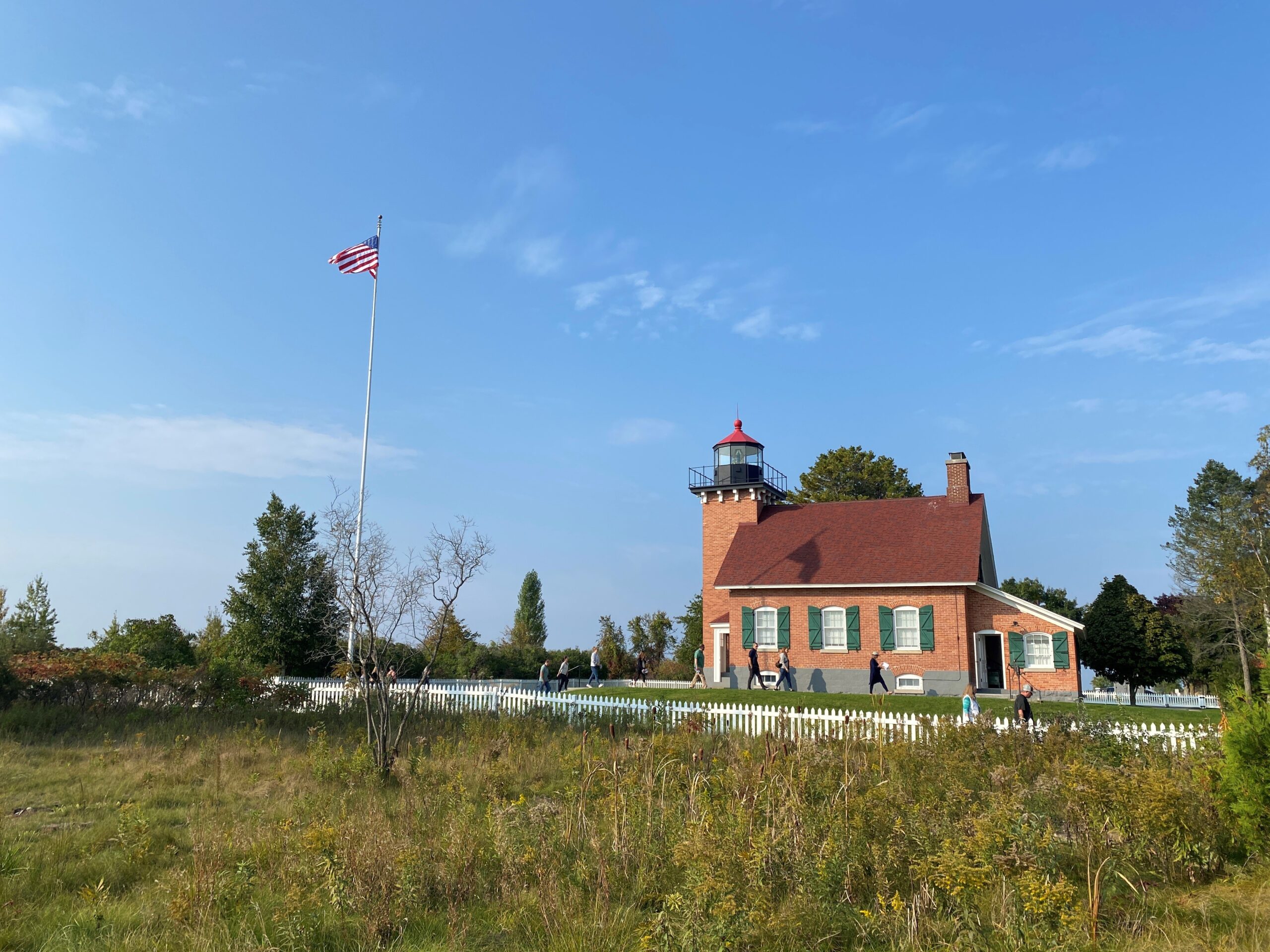Michigan has more lighthouses than any state (about 129) dating back to the mid-1820s. These majestic beacons were erected to guide mariners transporting iron ore and copper, lumber, fish, produce and eventually passengers throughout the Great Lakes region.
Most of these historic lights remain perched along the freshwater coastlines serving as a reminder of days gone by and offering a glimpse back in time. A handful even have an open- door policy, welcoming visitors to step inside for a more intimate experience.
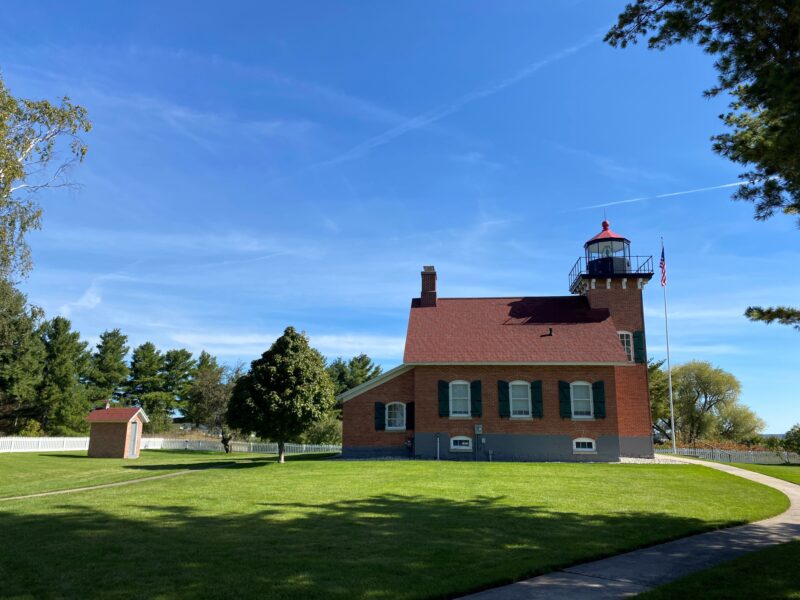
Little Traverse Lighthouse, photo by the Harbor Springs Historical Society
LITTLE TRAVERSE LIGHTHOUSE, Harbor Springs
One of the most illusive lights to visit is Little Traverse Lighthouse in Harbor Springs. On August 7, 1882, congress appropriated $15,000 to establish a light here and a 3.5-acre parcel was purchased by the U.S. Government from the Harbor Point Association the next year. Work began on the two-story red brick lighthouse and 40-foot-tall tower in May 1884. Perched atop the tower, a 10-sided cast iron lantern room would later house a fourth-order Fresnel lens. The light broadcast a fixed red light at a focal plane of 41 feet above the waters of Little Traverse Bay and Lake Michigan beyond.
Construction moved at a rapid pace and by fall, the lighthouse was completed. The first keeper was a woman named Elizabeth (Whitney) VanRiper Williams—one of about 50 women who served in this job in Michigan.* She exhibited the Little Traverse Light for the first time on September 25, 1884
Born on Mackinac Island and raised on Beaver Island, Elizabeth was thrust into the role of keeper of the St. James Harbor Light at Whiskey Point on Beaver Island in November 1872 after her first husband—Clement VanRiper—died trying to help crew of a sinking ship in the harbor. She dedicated her life to her service, sharing details in her 1905 autobiography A Child of the Sea. Nine years after marrying a local cooper (barrel maker) named Daniel Williams, the couple requested a transfer to the newly built Harbor Point Lighthouse (Little Traverse Lighthouse). They remained there until she retired on November 1, 1913, when they relocated to a lakefront house that she purchased for them in Charlevoix. The couple passed away, within about 24 hours of each other, in January 1938.
The Little Traverse Lighthouse was decommissioned by the U.S. Coast Guard in 1963 and was sold back to the Harbor Point Association. In the early 1990s, the association and its lighthouse committee began the task of restoring the lighthouse and surrounding property. They open it up to the public once every five years or so, working in partnership with the Harbor Springs Area Historical Society.
Tours will be offered this year on Saturday, October 5. Each docent-guided tour includes access to the main living areas including the kitchen as well as the second floor sleeping quarters. Guests will also be allowed to climb up to the tower to see the Fresnel lens and soak up unparalleled views of Little Traverse Bay. Tickets are $75 per person for these timed, 75-minute tours. For additional information and to purchase tickets, please visit: www.harborspringshistory.org/events/calendar/programs/lighthouse-tours.html
McGULPIN POINT LIGHTHOUSE, Mackinaw City
The land along the southwestern coast of the Straits of Mackinac has longstanding ties to the Native Americans who resided there well before the first European explorers arrived.
In 1774, John McAlpine—a British soldier who recently retired from Fort Michilimackinac—was gifted 640 acres in this area. The property was officially deeded to John’s son, Patrick McGulpin (the Anglicized spelling) in 1811. Patrick’s son, George, and his Native American wife were the next to settle in the area which ultimately became known as McGulpin Point.
The U.S. Lighthouse Establishment allocated funds in 1869 to construct a lighthouse at McGulpin Point—it was just the second light in the Straits of Mackinac (the first being Bois Blanc Island in northern Lake Huron, constructed in 1829).
According to Emmet County, which maintains the light, “work began at McGulpin Point early in 1869, and the station was built as a mirror image of the design used at Chambers Island and Eagle Bluff lights under construction in the Door County area that same year. This plan, which is sometimes referred to as the ‘Norman Gothic’ style, was also later also used at Eagle Harbor in 1871, White River in 1875, and at Passage and Sand Islands in 1882.”
Just five men tended to this lighthouse during its 37-year history—the most noted and longest-serving being James Davenport (1879-1906). Davenport had also served at nearby Waugoshance Shoal Light (1871-1873) and Little Sable Point in Muskegon County (1873-1879). He was brought in at McGulpin Point toward the end of the season, in September 1879 at a beginning salary of just $540 a year (a decrease in pay of $60 annually from what he had been receiving downstate).
By 1906, other lights had been illuminated within the Straits of Mackinac—St. Helena Island (1873), Mackinac Point (1889) and Round Island (1896)—and by 1910, the White Shoal Light would also rise out of the Lake Michigan waters. McGulpin Point Lighthouse was soon decommissioned and on December 15, 1906, Davenport climbed the stairs to the lantern room to fire up the light for the final time. He was transferred to Mission Point Lighthouse in Traverse City, serving until his retirement in 1917; he then returned to Mackinaw City where he lived until his passing in 1932 at the age of 85.
Left abandoned, the McGulpin Point Lighthouse was ultimately purchased in 1913 by Mackinaw City president and entrepreneur Sam Smith, for $1,425. Over the years, it was sold and sold again, until 2008 when Emmet County purchased the site and began its historic restoration to reestablish it as a private aid to navigation (PATON). The lighthouse museum was reopened and relighted on May 30, 2009—103 years after it had been extinguished.
McGulpin Point Lighthouse is located at 500 Headlands Road in Mackinaw City, not far from the Headlands Dark Sky Park, and is open for tours from mid-May through October (10 am to 5 pm). Admission is $3 per person (five and under are free). For information: www.mcgulpinpoint.org
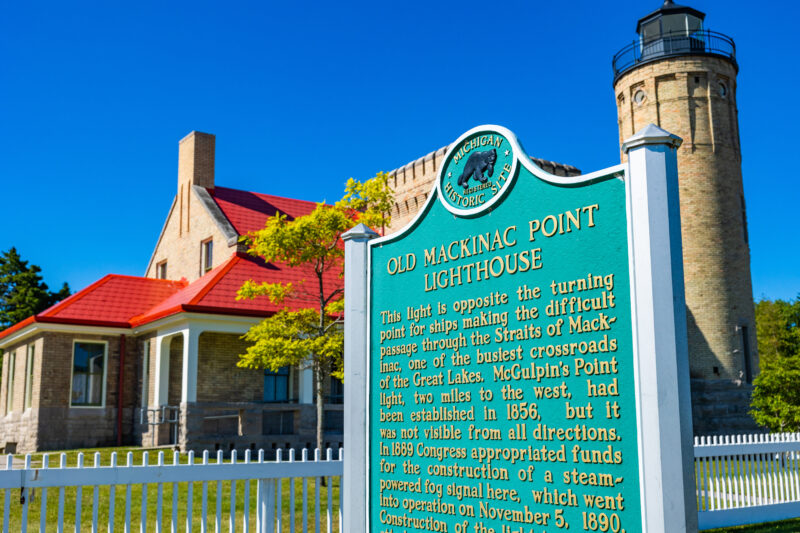
MACKINAC POINT LIGHTHOUSE, Mackinaw City
It took decades for a lighthouse to be constructed at the tip of Michigan’s lower peninsula to guide vessels traveling both east and west through the Straits of Mackinac. According to LighthouseFriends.com, Mackinaw was first recommended as a viable site in the summer of 1838, but other locales were ultimately selected—like McGulpin Point. It wasn’t until March 1889 that construction began on a light and fog signal building at Point Mackinac.
Known as the “Castle in the Straits” this regal-looking lighthouse housed about two dozen keepers over the years—many from the esteemed Marshall family. The “Old Sergeant” William D. Marshall was the patriarch of this family and while he was never a keeper he did serve in the military for 62 years and was the oldest man in the army of the United States when he died at the age of 83 in 1884. Among his descendants were at least 12 men (spanning four generations) who served at Straits area lights between 1870 and 1966 for a combined 310 years of service—including three at Mackinac Point (with an accumulative 53 years).
When the five-mile Mackinac Bridge, affectionately called “The Mighty Mac,” opened in 1957 with its 552-foot-tall lighted towers, there was no longer a need for the Mackinac Point Lighthouse. Three years later, the Mackinac Island State Park Commission purchased the light and integrated it into Michilmackinac State Park. In 1972, after $70,000 in restoration work, the lighthouse opened to the public for tours.
Located just east of the Mighty Mac and just off I-75, Old Mackinac Point Lighthouse is open for tours from early May through the first Sunday in October (the 6th in 2024). Admission is $10.25 for adults and $7.25 for children aged 5-12. Under 5 are free. The grounds are open year-round. For more information: www.mackinacparks.com/attraction/old-mackinac-point-lighthouse/
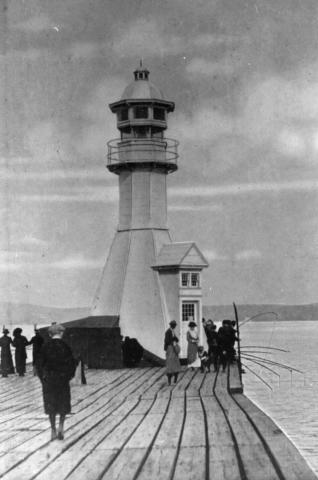
Previous Petoskey Pierhead Lighthouse Photo credit to US Coast Guard Historians Office c. 1913
PETOSKEY PIERHEAD LIGHTHOUSE, Petoskey
Most residents and visitors aren’t aware that Petoskey once displayed a unique Art Deco-esqu style lighthouse on the pier adjacent to the city marina. Construction began in 1896 on a breakwall that jutted out into the waters of Little Traverse Bay. Three years later, a metal post with a light atop was erected and first lit on July 1, 1899.
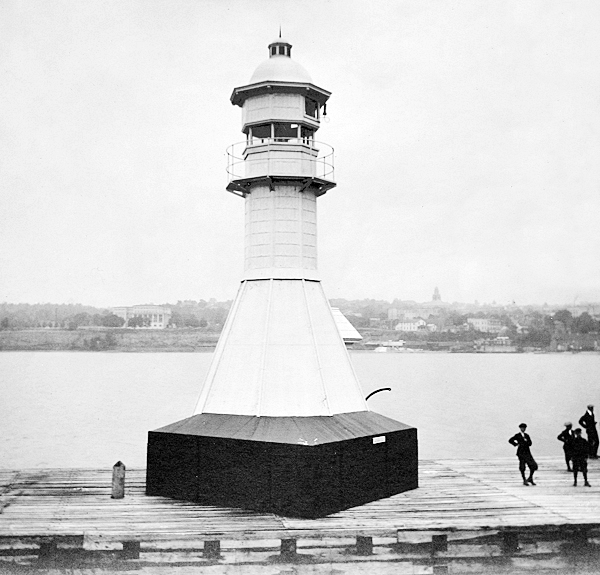
Photo credit: National Archives c. 1914
In 1903, structural steel and cast-iron metalwork were brought in to enclose the pier’s light post. However, for some reason, it wasn’t until 1913 that a 34-foot pyramid or funnel type structure with an ornate lantern room was complete. Similar artistic setups had been constructed in five other Lake Michigan cities—Waukegan in Illinois, as well as Kenosha, Milwaukee, Racine and Sheboygan in Wisconsin.
The distinct light in Petoskey stood proudly for just a dozen years until a severe storm in December 1924 washed it off the pier and into the churning waters below. The light had actually been extinguished for the season just six days before its demise. The following spring, a temporary light was erected on an unpainted post, operating until 1930 when a red 30-foot skeletal steel tower was placed.
Years ago, there was talk of rebuilding Petoskey’s light back to its 1913 style—but such initiatives take considerable funds (estimated to be about $250,000 based on 2010 figures). Perhaps someday, some generous soul with a passion for Michigan’s lighthouse heritage will help bring this vision to reality. For now, the existing conical light serves its purpose and the pier remains a popular attraction for locals and visitors alike.
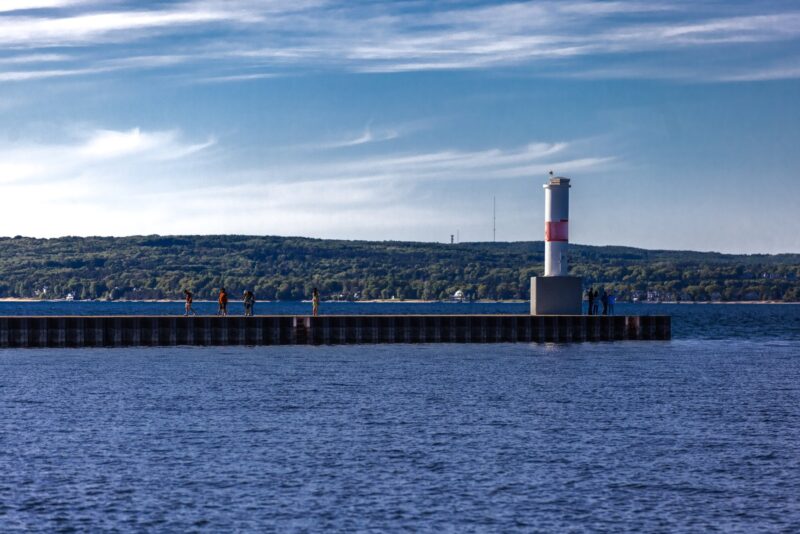
Current Petoskey Breakwall Beacon. Photo credit: Brandon Schadler/Petoskey Area Visitors Bureau
FOR MORE INFORMATION:
The premier resource for information about Michigan’s historic lighthouses is the Great Lakes Lighthouse Keepers Association: www.GLLKA.com.
Learn more about Elizabeth (Whitney) VanRiper Williams:
- A Child of the Sea: And Life Among the Mormons by Elizabeth Whitney Williams
- Harbor History Talk – Michigan’s Lighthouse Matriarch (Harbor Springs Historical Society Presentation by Dianna Stampfler)
- An Illuminating Lady – Elizabeth Whitney Williams (Michigan History Magazine article by Dianna Stampfler)
 About the Author: Dianna Stampfler is the president of Promote Michigan, founded in 2024. She has been researching the state’s historic lighthouses for more than 25 years and is the author of the best-selling books “Michigan’s Haunted Lighthouses” and “Death & Lighthouses on the Great Lakes.”
About the Author: Dianna Stampfler is the president of Promote Michigan, founded in 2024. She has been researching the state’s historic lighthouses for more than 25 years and is the author of the best-selling books “Michigan’s Haunted Lighthouses” and “Death & Lighthouses on the Great Lakes.”

